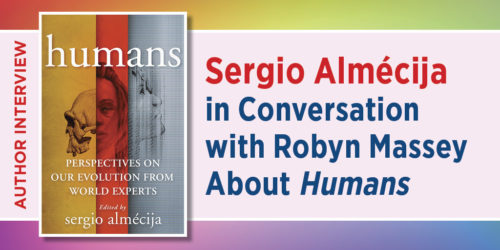Evolution and the Tools of Imagination — Christopher Collins
“When we open a book and turn its pages, our paleopoetic past is never very long ago or far away.”—Christopher Collins
The following essay is by Christopher Collins, author of Paleopoetics: The Evolution of the Preliterate Imagination
In both biological and cultural evolution there is no turning back, no do-overs. As I began planning the project that would become the book, Paleopoetics, the principle of evolutionary biology that change is cumulative intrigued me the most. Steven Mithen had put it this way: “Evolution does not have the option of returning to the drawing board and beginning anew; it can only ever modify what has gone before. That is, of course, why we can only understand the modern mind by understanding the prehistory of the mind.” Culturally evolved skills, such as fire use, cooking, agriculture, writing, mathematics, and empirical science, like the genetically inherited traits upon which they are built, have been preserved and elaborated to generate further innovations, a progressive process that Michael Tomasello has called the “cultural ratchet.”
Then the idea struck me: there is no turning back because we carry within us our own biological past and nowhere is that past more systematically present than in our brain. It follows then that biological and cultural evolution form a continuum and, though the older functions of the brain are manifestly different from the newer functions, both sets are interdependent thanks to the plasticity of this organ. I subsequently became aware of “dual-systems theory,” a cognitive model that differentiates such opposites as impulse and planning, parallel and serial processing, nonverbal and verbal communication, and concrete and abstract thought. The primary goal of dual-systems theory is to explain illogical, maladaptive human behavior as the result of an unresolved conflict between the prehuman and the fully human brain.
While I find myself agreeing that conflict can arise when these opposite features compete for dominance, I can also see them as complementary functions. In Paleopoetics I explore the possibility that the arts, specifically the verbal arts, integrate these opposites, momentarily reconciling the old, long established modular centers with the more recently connected circuitry of the anatomically modern brain.
Storytelling, song, drama, poetry, and prose fiction do so by requiring us temporarily to suspend disbelief and inviting us to tolerate contradictory points of view and counterfactual propositions. Fictionality also creates what Gregory Bateson called “play frames,” conventional rules that allow the otherwise destructive impulses and overwhelming emotions of the prehuman primate brain to consort freely with the tentative, probing consciousness of the new brain. Under the auspices of the play principle, the two “systems” come together in a creative dyad, not unlike Nietzsche’s union of the turbulent Dionysian spirit with the calm, visionary spirit of Apollo.
Except for the fact that a verbal composition is a piece of play equipment, it is just as much an artifact as is a stone ax, a ceramic bowl, an astrolabe, or a cellphone and, like any other tool, it is made in order to extend the power of its user. Whenever verbal artifacts—songs, stories, dramas, and poems—first appeared, they too had the defining characteristics of human tools: each was carefully constructed, made to serve a specific purpose, and preserved for future use. Moreover, each verbal artifact extends a different set of human powers that may include social intelligence, object and environmental knowledge, empathy, perspective taking, as-if play, long-term memory, visual imagination, and thought as mediated by subvocal speech. It extends human power in two ways: it amplifies the insights it contains and, as an artifact crafted out of language, it transfers those insights to other minds.
As I suggested earlier, there is perhaps an even more profound function that verbal artifacts serve. If we consider them from an evolutionary perspective, we must ask our selves what survival and reproductive advantages they confer on those that use them. The answer I would propose is this: the verbal arts are the principal means our species has devised to bridge the gap that first appeared around 2.5 million years ago, a gap that has since grown wider and wider between our inherited primate self and our culturally modified self. This powerful, reintegrative function, I suggest, explains why venturing into imaginary places and seeing through the eyes of imaginary persons can move us so deeply. It also explains why verbal artifacts, whether publicly performed or read in solitude and silence, have been associated with the irrational, the dreamlike, and the uncanny.
The gradual transition from storyteller to book, from public performance to predominantly private reading, altered the verbal artifact in a number of ways. In a traditional oral culture, a song or story would either have an unknown source or be attributed to some legendary prophet, sage, or demigod. In a literate culture, such compositions are the work of professional writers, authors, and, as written texts, are no longer stored in memory and reshaped by the performer’s art. Though much has changed, much has remained. The verbal artifact now exists as a solid, visible object, more palpably tool-like than ever before. The social setting, be it the campfire, the mead hall, or the amphitheater may be gone, but the tool-using performer is still there. It is now the reader, the erstwhile listener, that has become the performer of the work. When we open a book and turn its pages, our paleopoetic past is never very long ago or far away.


